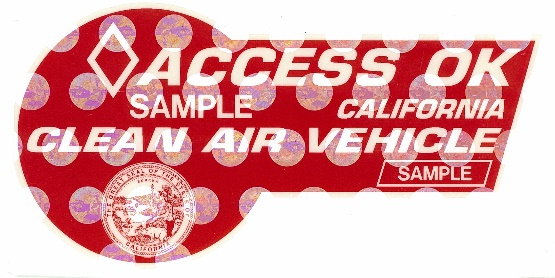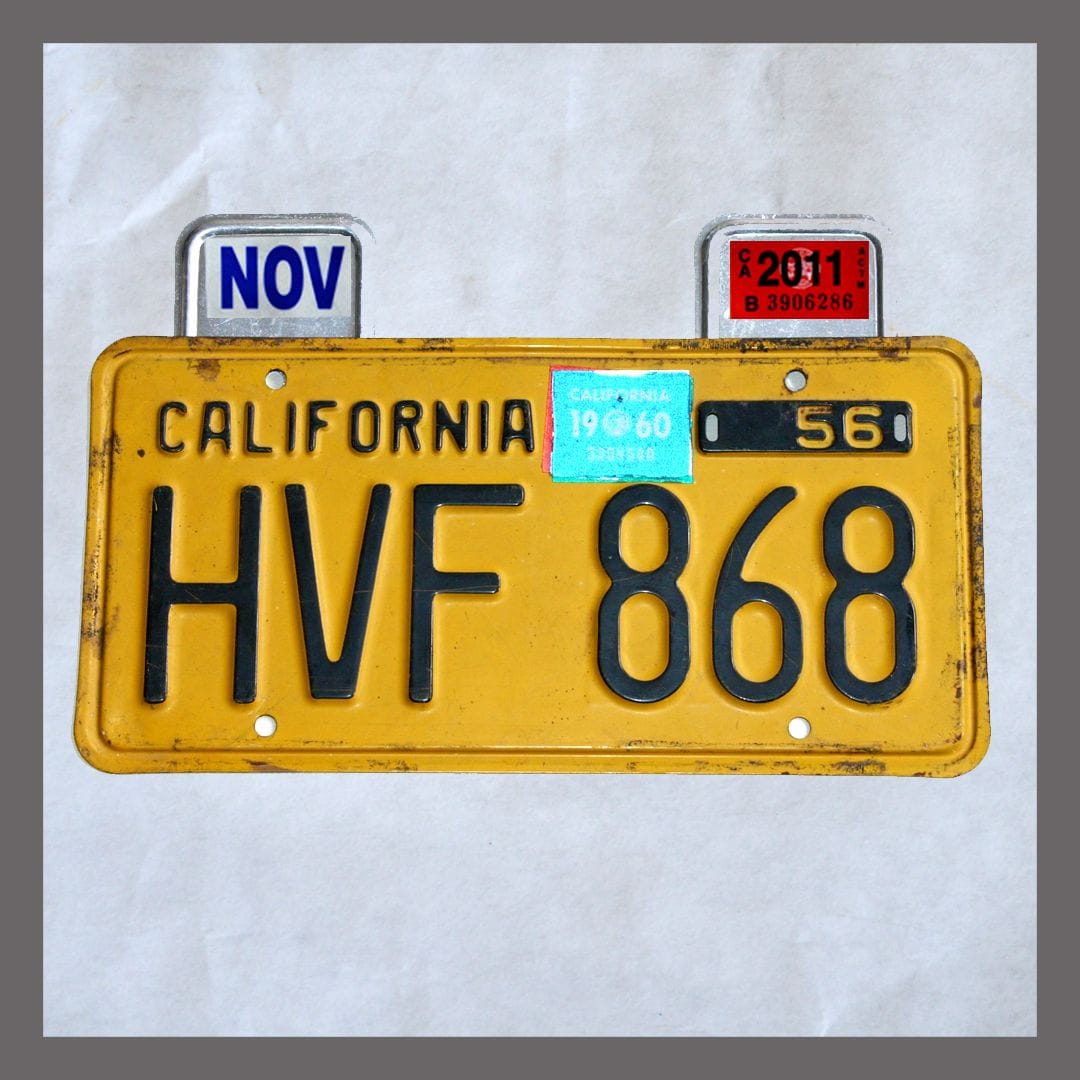| California 1969/70 passenger issue. Gold-on-blue plates were introduced starting in 1969, and again vehicles of that era would still carry their original plates with proper stickers. Most of these plates were issued with 1970 as their first expiration, but a handful got out with 1969 stickers. In fact, some plates issued in late 1969 received their 1969 and 1970 stickers at the same time due to the late-year registration. This plate has the same narrower dies for the state name as the older 1963-era plates had. This series of plates started off with a 123-ABC format, later changed to 1ABC234 when the series was exhausted. Gold-on-blue plates were issued through the end of 1986 in California. |
| California 1977 passenger issue. Later period California blue plate. This plate features a wider die set for the state name and smaller sticker wells at the top corners. This series began in 1975 starting with plate number 501-LXU. This plate also has a month sticker, as California adopted staggered registration starting with 1976 expirations. |
| California 1978 passenger issue. Another variant on the blue base, plates starting in 1977 in the late 'S' series through approximately the 'WKZ' series carried these fatter serial dies. This variation was fairly short-lived, only lasting a year or so before the next set of dies was rolled out (see next.) |
| California 1981 passenger issue. In late 1977, at the beginning of the 'WLA' series of plates, California switched to narrower dies for the serial numbers on these plates. This was done at this time due to an exhaustion of available six-digit commercial plate combinations, making that the first series to switch to seven digits. Passenger plate would follow suit in 1980, see next. Similar dies are still in use today. |
| California 1982 passenger issue. In April 1980, the regular 123-ABC series was exhausted and California switched over to a 1ABC234 format. This numbering sequence is still in use today, with plates having passed the 7AAA000 mark in March, 2013. Some of these seven-digit blue plates have the letters 'CA' lightly etched in the upper left sticker well. I have one of these, in the '1MVR' series, but the etching wouldn't show up in a scan so it is not included on this page. |
| California 1984 passenger issue. The 'Golden State' baseplate was introduced in December 1982 and was an optional baseplate issued concurrently with the gold-on-blue seven-digit base until the end of 1986 for an additional $5 fee. This plate then became the general issue from January through October of 1987. Plates were issued starting with 2AAA000 and ending up around 2GPZ999, making this a rather rare (by California standards) variety. These plates are also still in use today on cars originally registered with them, and are considered to be something of a status symbol. This plate was awarded ALPCA's Plate of the Year award for 1983. |
| California 1986 passenger issue. Another of the Golden State plates issued during the period where the plate was still an optional issue. This plate has a lightly debossed 'CA' in the lefthand sticker box. This does not appear very easily in the scan, but is more readily seen by looking at the back of the plate. This feature was added to stem concerns that these new screened plates could still be identified as California plates in cases such as a fire when the screened background was somehow obliterated. |
| California 1987 passenger issue. Blue seven-digit plates were issued concurrently with 'Golden State' bases through the end of 1986, confirmed into the '1SWC' series. These blue plates were then discontinued. Plate numbers in the '1' series after this point were not used and are now being issued on some special-issue California bases. This plate also uses the redesigned blue-on-white month sticker, introduced with exp. 1986 plates and still in use today. |
| California 1988 passenger issue. As mentioned before, starting in January, 1987, this plate became the general issue for the state for a whopping ten months. Some Golden State plates manufactured near the beginning of this stretch were made on old blue blanks to use them up. If you look closely at this plate, you can see blue sticking out along the edges of the plate. If California's DMV had any sense of humor, they would have issued this entire '2DRY' series in the Death Valley area, but they probably didn't. |
| California 1988 passenger issue. Red and blue-on-white reflective plates were introduced in California in October 1987. This series started at the '2GQA' series, picking up where the 'Golden State' graphic base had left off. California had passed a law requiring that all plates be made reflectorized, and the change to this more generic base from the 'Golden State' baseplate was supposedly made to curb plate production costs. The result was one of the more boring periods of California plate history, I must say. |
| California 1993 passenger issue. Continuation of the plate series above, when the end of the '2' series of plates was reached in 1992, the plate series changed over to 3AAA000. Plates of this type were observed through the '3FMG' series, when the baseplate was changed. |
| California 1995 passenger issue. This variation of California baseplate features the state name scripted across the top in red. This plate series started with the '3GAA' series, and was used through approximately the '3XZZ' series. Earlier versions of this plate (3GAA-3KOA) used a smaller script for the state name, while later ones (from the 3N-3P series or so) enlarged the script somewhat. This is a plate from the first series, with the smaller script. |
| California 1996 passenger issue. Variation number two of the Script plate, this plate features the 'medium' size for the script which was used from the 3KOB series through somewhere in the 3N/3P series. |
| California 1998 passenger issue. This is the third of the variations on the Script plate, with the largest size used for the script on the state name. Production varied between the previous (medium) sized script and this larger one through the 3N and early 3P series before this larger script came into consistent use early in the 3Ps. Apparently this time the state name was finally written large enough, as this size has been retained ever since. |
| California 1999 passenger issue. Starting in early 1998, the Script base was modified again to add the (rather redundant) slogan 'Sesquicentennial - 150 Years'. These plates were issued starting with plate number 4AAA000, skipping the 3YAA000-3ZZZ999 block entirely. This plate celebrates the 150th anniversary of California statehood in 2000. Plates with this slogan were issued through late 2000. |
| California 2002 passenger issue. Near the end of 2000, at the '4NPA' series of plates, the 'Sesquicentennial' slogan was removed from the plate, resulting in an issue identical to the series of plates immediately before the Sesquicentennial issue. This is once again the current design of California plate, now being issued in the 5 series. |
| California 2004 passenger issue. Continuation of the series, the state crossed over into the 5 series in January 2003. Issuance of this series has been steady, reaching into the 6 series by 2007. |
| California 2007 passenger issue. Minor variation alert - at some point in 2005, at least one of California's plate-stamping presses seems to have been re-tooled, replacing the traditional debossed border die with a flat, beveled edge instead. This variation began to appear sporadically in the late 5 series, only affecting the percentage of plates produced on the retooled equipment. Plates with each border type are still appearing into the 6 series. |
| California 2012 passenger issue. In late 2011, reportedly starting in the 6TPW series, the state added their DMV web address to the bottom of the standard passenger issue. The plates otherwise remain unchanged. |
| California 2014 passenger issue. California passed into the 7 series in mid-2013, which was nearly exhausted as of July, 2017. Conjecture has begun as to what the next series will be, although at current issuance rates, that probably won't be known for another 7-8 years. If the commercial series is any predictor, the likely successor is 123ABC4, with the last number remaining static for an entire series, pretty much the opposite of the current. |
| California 2019 passenger issue. The state rolled into the 8 series in the summer of 2017. The website base continues unchanged since its introduction in the late 6 series. |
Additional California information provided by: Jon Miller, Dave Hermanson, Scott Broady, Alan Erland


2009 California Vehicle Code - Section 5200-5206:: Article 9. Display Of Plates, Tabs, And Stickers VEHICLE CODE SECTION 5200-5206 5200. (a) When two license plates are issued by the department for use upon a vehicle, they shall be attached to the vehicle for which they were issued, one in the front and the other in the rear. Extra-cost optional plate until 1987, when it briefly became the standard passenger base after the 1969 blue base was discontinued. Awarded 'Plate of the Year' for best new license plate of 1983 by the Automobile License Plate Collectors Association, the first and, to date, only time California has been so honored. Late 1987 – early 1994. California Reg Sticker colors 1957-62, and then 1964-present. Information courtesy of The Andrew Turnbull Network: www.andrewturnbull.net/plates Michael Kustermann's 'License Plates of the World': www.worldlicenseplates.com/hp.html (for more information on plates and not stickers). Appendix 1E - California License Plate Data (1914-1980).0105 Automobile License Plates, continued Year Plate Color Character Color Comments Plate Data Plate Material 1944 Black Mustard Yellow A paper sticker measuring attached inside the windshield was issued for use with 1941 or 1942 license plates. The sticker measured 3” by x 2 1/2”.

| Ahead to Colorado |
| Back to Arkansas |
Return to U.S. Plates Index
 © Copyright 1998-2020 David Nicholson. All Rights Reserved.
© Copyright 1998-2020 David Nicholson. All Rights Reserved. California License Plate Month Sticker
Last Modified 1/20/2020 (added 2019 plate).